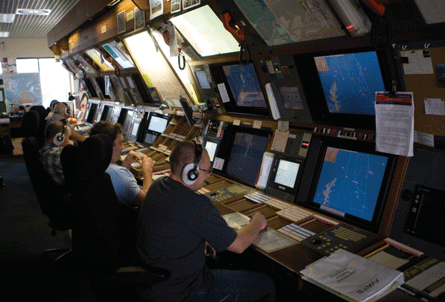UK air navigation service provider NATS is about to make the first use of wide-area multilateration for aircraft surveillance in an offshore environment, going live in the North Sea with the first stage at the end of September this year.
This will have many positive repercussions for safety because, at present, the onshore radar can only "see" helicopters up to 150km (80nm) from the radar head, which leaves all but a few of the offshore oil and gas platforms beyond existing surveillance at the low levels helicopters use (see diagram).
Helicopters serving the rigs are controlled from the NATS radar operations room in Aberdeen airport's tower. The aircraft are followed by radar until out of range, and are covered by a procedural service beyond that. This is operated by sending crews outbound along specific radials from the Aberdeen VOR/distance measuring equipment beacon, and inbound along others that are at least 3° separated from the outbounds.
Outbound is also at odd thousands of feet, and inbound evens. The pilots are responsible for separation by see-and-avoid, but controllers provide them with the best traffic information they can as well as procedural clearances.
When the multilateration goes live later this month the land-based radar controllers will still be working with today's displays, but there will be another display that provides radar-like real-time coverage around the rigs, so they can track aircraft all the way to the helidecks. They will also be able to track rig-to-rig flights. Eventually they will have a single display that integrates the radar and the multilateration pictures, but that is some years away yet.
 |
|---|
© NATSControllers see further with multilateration |
Even with the multilateration system operating, pilots will only be provided with the equivalent of a radar information service, and they will still remain ultimately responsible for separation. The difference, says NATS general manager at Aberdeen John Mayhew, will be in the vastly improved traffic information they will be able to provide to crews. That is, in itself, a safety benefit, says Mayhew, but the other safety improvement will be in the speed and accuracy of an emergency response.
Under procedural control, crews report their position roughly every 10min, so if they disappear immediately after a position report with no emergency call, it will be up to 10min before anyone has cause to ask where they are.
With real-time surveillance, if an aircraft goes missing its absence will be not only be noticed almost immediately, but its last position will have been recorded.
The multilateration hardware consists of signal transmitter and receiver stations fitted to 16 offshore oil and gas platforms in the central North Sea. These will identify and track helicopters in real time by interrogating their transponders and measuring the time-difference in the responses at the various receiver stations. Activity will show on radar-like displays at Aberdeen.
With a range of about 75km, the stations can obtain line-of-sight responses from the helicopters' transponders at enough individual stations to fix the aircraft, and the fixes are fed back to NATS controllers at Aberdeen. Reception of transponder response at three stations is a minimum for fixes, and four is optimal.
The system - provided by US specialist Sensis - is less costly and more accurate than radar, with a faster update rate, says Mayhew.
Three clusters of four stations each have been set up. The system will begin operation for flight trials "later this month", says NATS. The fourth cluster, on the southernmost group of rigs, will be ready by January, and the whole system will become fully operational by June 2010, providing surveillance over more than 50,000km2 (19,300 miles2) of the North Sea where, previously, there had only been procedural control.
Oil & Gas UK says a "big advantage" of the system is that it will cut the risk of a collision with a fixed-wing military aircraft.
Source: Flight International



















